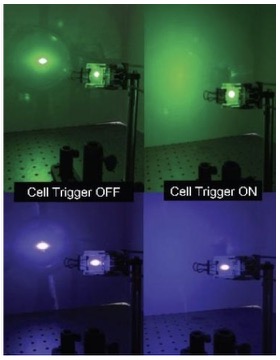Home
A comprehensive resource for safe and responsible laser use
US: New technique for scattering laser light on aircraft windscreens
The research was presented by Jason Keleher, Ph.D. and research assistant Daniel Maurer on March 31 2019 at an American Chemical Society meeting in Orlando, Florida. Here is a summary:
"To develop their new approach, the researchers took advantage of liquid crystals -- materials with properties between those of liquids and solid crystals that make them useful in electronic displays. The team placed a solution of liquid crystals called N-(4-methoxybenzylidene)-4-butylaniline (MBBA) between two 1-inch-square panes of glass. MBBA has a transparent liquid phase and an opaque crystalline phase that scatters light. By applying a voltage to the apparatus, the researchers caused the crystals to align with the electrical field and undergo a phase change to the more solid crystalline state.

Liquid crystals sandwiched between two1-inch squares of glass (left images) scatter green and blue light on a wall when the cells are triggered by laser illumination (right images). Image credit: Daniel Maurer, Lewis University
"The aligned crystals blocked up to 95 percent of red, blue and green beams, through a combination of light scattering, absorption of the laser's energy and cross-polarization. The liquid crystals could block lasers of different powers, simulating various distances of illumination, as well as light shone at different angles onto the glass.
"In addition, the system was fully automatic: A photoresistor detected laser light and then triggered the power system to apply the voltage. When the beam was removed, the system turned off the power, and the liquid crystals returned to their transparent, liquid state. "We only want to block the spot where the laser is hitting the windshield and then have it quickly go back to normal after the laser is gone," Keleher notes. The rest of the windshield, which was not hit by the laser, would remain transparent at all times.
"Now that the researchers have shown that their approach works, they plan to scale it up from 1-inch squares to the size of an entire aircraft windshield. Initial results have shown that a sensor grid pattern on 2-inch squares of glass will respond only to the section of glass that is illuminated. The team is also testing different types of liquid crystals to find even more efficient and versatile ones that return to the transparent state more quickly once the laser is removed."